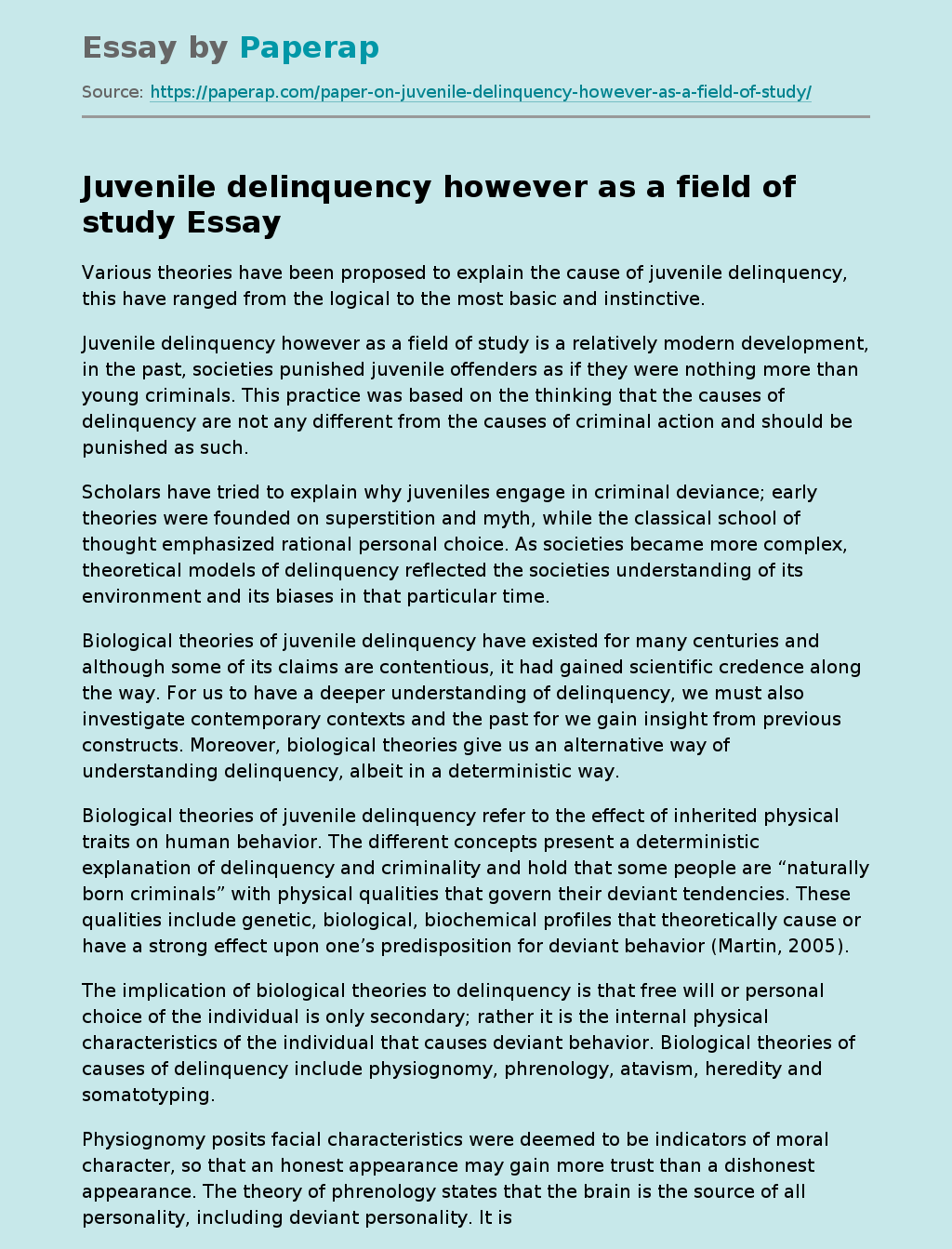Juvenile Delinquency However as a Field of Study
Various theories have been proposed to explain the cause of juvenile delinquency, this have ranged from the logical to the most basic and instinctive. Juvenile delinquency however as a field of study is a relatively modern development, in the past, societies punished juvenile offenders as if they were nothing more than young criminals. This practice was based on the thinking that the causes of delinquency are not any different from the causes of criminal action and should be punished as such.
Scholars have tried to explain why juveniles engage in criminal deviance; early theories were founded on superstition and myth, while the classical school of thought emphasized rational personal choice. As societies became more complex, theoretical models of delinquency reflected the societies understanding of its environment and its biases in that particular time.
Biological theories of juvenile delinquency have existed for many centuries and although some of its claims are contentious, it had gained scientific credence along the way. For us to have a deeper understanding of delinquency, we must also investigate contemporary contexts and the past for we gain insight from previous constructs.
Moreover, biological theories give us an alternative way of understanding delinquency, albeit in a deterministic way.
Biological theories of juvenile delinquency refer to the effect of inherited physical traits on human behavior. The different concepts present a deterministic explanation of delinquency and criminality and hold that some people are “naturally born criminals” with physical qualities that govern their deviant tendencies. These qualities include genetic, biological, biochemical profiles that theoretically cause or have a strong effect upon one’s predisposition for deviant behavior (Martin, 2005).
The implication of biological theories to delinquency is that free will or personal choice of the individual is only secondary; rather it is the internal physical characteristics of the individual that causes deviant behavior. Biological theories of causes of delinquency include physiognomy, phrenology, atavism, heredity and somatotyping.
Physiognomy posits facial characteristics were deemed to be indicators of moral character, so that an honest appearance may gain more trust than a dishonest appearance. The theory of phrenology states that the brain is the source of all personality, including deviant personality. It is said that lumps, bumps, indentations, protuberances and other cranial features were considered to be indicators of brain development.
The theory of atavism postulates that criminals could be identified by primitive physical anomalies present at birth, however it states that it does not determine criminality but are indicators of criminal predisposition. Heredity has also played a major role in explaining delinquent behavior, especially in inquiries related to the occurrence of criminality in families.
The theory states that deviance is genetically encoded in those born into a family group that has deviant traits. A modern development in the theory of heredity is chromosome theory, it is believed that individuals who commit crimes carries with them an extra Y chromosome or the super male syndrome, it was found that males with the extra Y were more common in prisons rather than in the society (Jacobs, 1965).
Somatotyping is another revision of an older theory on body types, this sought to identify certain body types that are more likely to be found among offenders, of the three body types, Sheldon found that mesomorphs (people who are muscular, sinewy, narrow in the waist and hips, and broad shouldered) were found to be juvenile delinquents.
The biological theories on juvenile delinquency tried to explain the causes of delinquent behavior, as such it has been in a limited way because it does not account for personal choice or the individual. But this is really the thrust of the biological theories; it removes personal accountability for one’s actions and instead is governed by the internal processes and characteristics of one’s body.
The biological theories gave me an opportunity to think at how myopic our view of human behavior was in the past, but nevertheless it also displays man’s ingenuity in searching for answers. In real life however, there is truth in the claims of the biological theories, like when we seem to feel good about children who are pleasant looking, and why we shun children who are not.
There is even almost this stereotype that juvenile delinquents resemble mesomorphs in body types, and that we often hear people say that children are sometimes born evil. Thus, it can be said that even if biological theories are outdated and needs to be scientific, it nevertheless is a tool to broaden our understanding of delinquency.
References
- Canter, Rachelle. (1982). Family Correlates of Male and Female Delinquency. Criminology 20:149-67.
- Howell, J.C. 2003a. Preventing and Reducing Juvenile Delinquency: A Comprehensive
- Framework. Thousand Oaks, CA: Sage Publications.
- Jacobs, P., Brunton, M., & Melville, M.M., (1965). Aggressive behavior, mental subnormality, and the XYY male. Nature, 208, 1351-1352
- Martin, G. (2005). Juvenile Justice SAGE Publications, Inc.
Juvenile Delinquency However as a Field of Study. (2018, Aug 10). Retrieved from https://paperap.com/paper-on-juvenile-delinquency-however-as-a-field-of-study/

